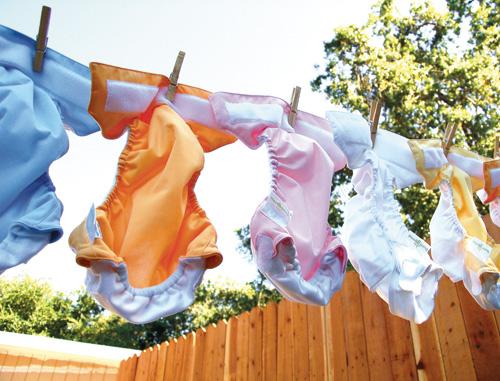If you’re a new parent, or soon-to-be parent, the mere mention
of cloth diapers probably conjures up thoughts of accidentally
poking your baby with a diaper pin, folding the diaper wrong
leaving you wet and sorry or having to dunk the white cotton flat
cloths into the toilet to “pre-rinse.”
But modern cloth diapers are much different than they once were.
Like everything else over time, the cloth diaper industry has
revolutionized over the last 10 years. Today, parents can choose a
“Fitted” diaper, “All-in-One” diaper, “Pocket” diaper or good
old-fashioned “Prefolds.”
And, like everything else, with the new versions of cloth
diapers, you get what you pay for. Many are more expensive, but the
advantages, many mothers say, outweigh the cost. Whether you made
the choice to go with cloth for environmental or financial reasons
or for convenience (no late night runs to the store to pick up
disposables after realizing you’re down to your last one), there
are still more decisions about your cloth diaper stash left to
make.
There are many questions that immediately come to mind when
making the decision of cloth versus disposable. How do you wash
them? How many do you need? Is it really worth the time and money?
What do you do with the … solids? What types of cloth diapers are
best?
First, you have to decide if it’s “worth it” for your family.
You know it’s probably best for the environment and probably best
for your baby’s bum. But, you also have to decide what’s best for
your budget, your what’s going to work for your baby and your
family.
A new mom looking for information on different alternatives for
diapers will find differing opinions on the Internet and likely
among friends. Some say disposable diapers make up tons of acres in
the landfill, while others say cloth diapers use too much water,
having to wash multiple times.
With all the pros and cons, it really comes down to personal
preference. For my family, cloth diapering works. I researched for
nine months (while I was pregnant) and picked the diapers I thought
would be most convenient and easiest to transition to (after using
disposables for the first few weeks, mostly to get through the
“tar” stage).
THE COST
To start one child with cloth diapers, you’ll need anywhere from
24 to 36 cloth diapers. Depending on which diapers you choose, that
can run anywhere from $200-$1,000. Of course, you’ll also need a
diaper pail and detergent, as well as an optional re-usable cloth
diaper bag for your pail and cloth wipes.
Most estimates say an average baby will go through about $1,500
to $2,000 in disposable diapers. Compare that to the average $500
you’d spend on reusable cloth diapers, and you’ve got quite an
argument to begin with. Even more so if you have more than one
child and you can reuse your cloth stash.
TYPES
Prefolds – Require a cover and fastener or pin. Definitely the
cheapest way to go, but may be more time consuming and require some
“know-how” (to fold, fasten, etc.). Usually, covers, purchased in
different sizes as the baby grows, can be used more than one time
before being washed.
All-in-One – Just as the name implies, it doesn’t require a
cover, usually the outer layer of the diaper is water proof. It
functions like a disposable diaper, one use and you throw the
entire diaper in the wash. One of the more expensive diapers.
Pocket diapers – Similar to the All-in-One except that an
absorbent cloth is stuffed into a “pocket” inside the diaper. Goes
on like a disposable, but both the cover and absorbent cloth go
into the wash after one use. It’s faster to clean than the
All-in-One since the two pieces come apart. You can adjust for
absorbency by adding thicker cloth into the pocket when needed.
Fitted diaper – Again, requires a cover and fastens with snaps
or velcro. It’s not quite as convenient as an All-in-One, since
covers are needed, but they typically fit snug under the diaper
covers reducing leakage.
HOW TO
Once you have chosen which diaper you prefer, you probably still
have questions about the process. We’ll use pocket diapers as an
example. Once you change your baby’s wet diaper, you can simply
toss the entire diaper (pocket insert and all) into a simple diaper
can (a kitchen garbage can with a lid will do), lined with a
reusable cloth bag. If your baby has started eating solid foods,
the diaper may need to be shaken over the toilet to remove the
waste.
If you’ve chosen to use cloth wipes as well, those can be tossed
into the same bin. After a few days, or when your bin is full, take
the entire reusable diaper bin bag and empty it into the washing
machine, throwing the bag on top. Most diapers require a cold wash
(sort of a pre-wash), then a hot wash. The diapers can then be
tossed into the dryer or put on a clothesline to dry.
While that may seem like a long process, it really only adds two
to three loads of laundry per week and not much more time than
having to throw disposables away in the trash.
TO LEARN MORE
There are many web sites dedicated to helping new parents
explore the cloth diapering world:
www.allaboutclothdiapers.com
www.diaperjungle.com
www.diaperjunction.com
www.clothdiaperblog.com
51.5
F
Healdsburg
April 26, 2025









